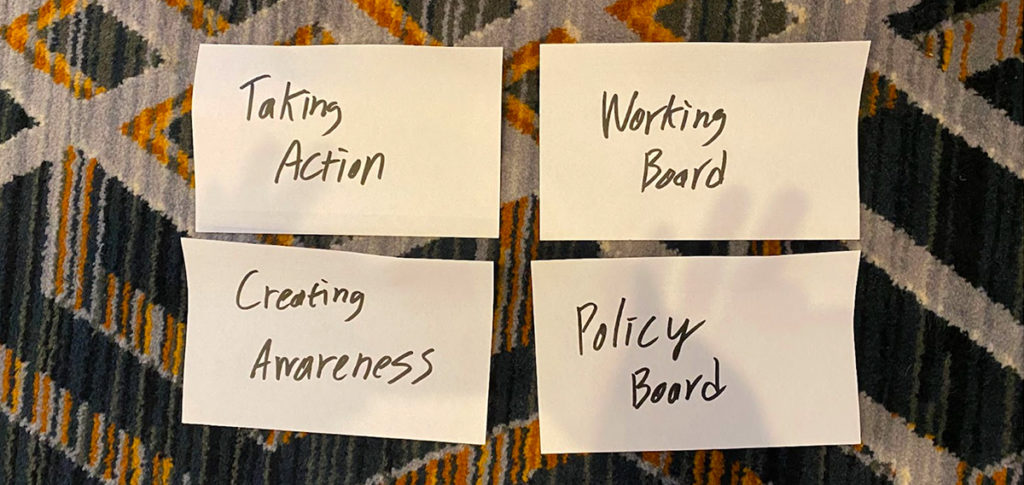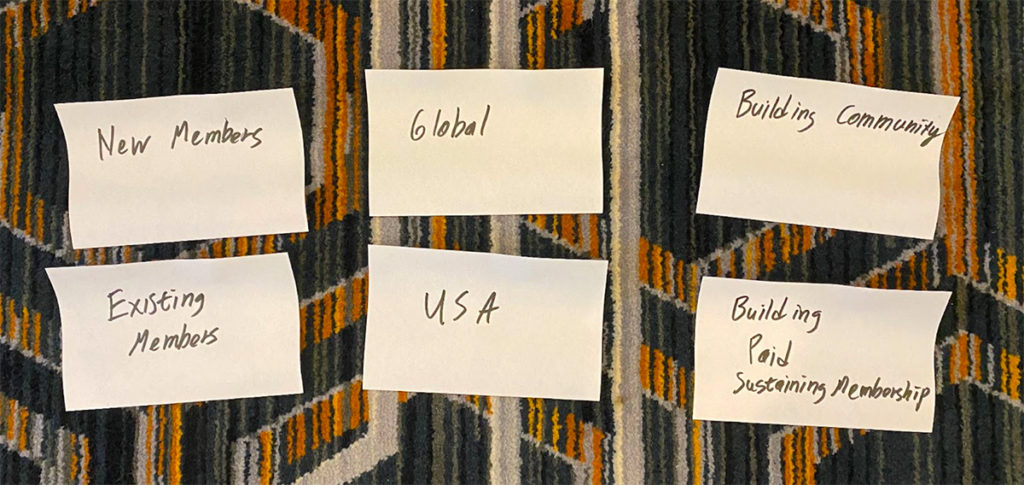Every group has a point where their working plan comes off the rails. This happens even with the most experienced Agilists – such as your Agile Alliance Board of Directors. The Board met in October and I had the honor of serving as the facilitator, and this is our story of “tensions and polarities” and how we dealt with these “the Agile way.”
The plan from which we will deviate
At the beginning of the meeting, I shared with the board that the agenda was “the plan from which we will deviate.” But it wasn’t until the beginning of day two that we discovered an urgent need to do so. We couldn’t quite figure out what was wrong, but it was clear the next activity we planned was not what we needed.
As a facilitator, I’ve learned that when a group hits a big enough snag, you must step out of the task-oriented work and address the dynamics. So that’s what we did. Someone pointed out a lot of tension in the room, and it seemed people approached the work from different perspectives. The value of working in a diverse group, of course, is that you have these perspectives. However, differences in viewpoint can seem like interpersonal conflict when they aren’t made explicit. The board needed to understand how these “tensions” were impacting how they worked – and how to take advantage of them.
Exploring the tensions between two poles
After a short break to make a “good enough” plan, I introduced the idea of tensions between two poles. There is always a spectrum between two seeming absolutes. I named two things I thought the group was struggling with and wrote each on large index cards. At one end of the room, I placed a card on the floor that said, “Creating Awareness.” At the other end, I placed one that said, “Taking Action.”
I asked each board member to stand at a point between these two cards that expressed their experience of the board meeting so far. After people moved into their spots, I asked about what led them to choose that location. Then, I asked them to move to the place along the spectrum where they were the most comfortable. Everyone moved. No one said that their experience of the first day matched what they were most comfortable with. This discovery started to make some sense of what they were feeling.
There’s no right or wrong place to be
It also allowed me to introduce a key point about polarities like these. There was no “right” or “wrong” place to be all the time. Managing the dynamic tension between the poles required that elements of both be present. We briefly explored this by asking someone whose preferred place was close to “Creating Awareness” what value they saw in “Taking Action” – and vice versa. It became clear that awareness without action was useless, and acting without a good enough understanding was likely to be counterproductive. In this way, the board built an appreciation for the different viewpoints in the room. Different perspectives are potential sources of wisdom, but only if the group doesn’t let the potential for conflict take over.
We repeated the exercise with a second pair: “Working Board” and “Policy Board.” Part of the strategic direction of the board over the last few years has been to hand over more and more of the operational work of the Alliance to the managing director. The board sees its role primarily as setting direction, establishing boundaries, and approving high-level plans (after questioning and due diligence, of course). The first question I asked around this pair was how they felt they had been operating during the first day: More like a working board or a policy board? Again, people moved to where their experience told them was right, and then we debriefed. Then, I asked them to move to where they wanted to be working – and everyone moved toward the “Policy Board” end. This provided another valuable insight: Even if they disagreed about where they were, they all wanted to move in the same direction.

By now, the board exposed the underlying dynamics of what was happening in a way that they could address and repair them directly. (It also gave me, as the facilitator, good ideas of how to re-plan the rest of the day.) They were also familiar enough with the activity to use it in their work.
At this point, I asked the board to shift their perspective from their experience of the first day to the work of the Agile Alliance in recent years. We explored three pairs in sequence:
- “Existing Members” and “New Members”
- “USA” and “Global”
- “Building Community” and “Building Paid Sustaining Membership”
For each of these, I asked two questions:
- Where do you think the focus of the Agile Alliance’s work has been?
- Where do you think the focus of the Agile Alliance’s work needs to be?
It didn’t matter that the poles weren’t precisely defined. As people talked through their reasons for standing where they were, they better understood how people thought about these ideas. Exploring the different perspectives that board members brought also helped them notice things they hadn’t before.

Assessing everyone’s insights
We closed by gathering into groups of three, talking about what insights people had during the activity, and then sharing a few with the entire board. One common takeaway was there was no “wrong” place to be and that there was value in all of the viewpoints people brought. Another was a tension between where people thought the focus of the Alliance needed to be in the next year and where they wished it could be. Exploring the “Pragmatic” and “Idealistic” spectrum would have to wait for another time.
Crucially, the board had exposed and explored some underlying dynamics getting in the way of its task-oriented work. Armed with these new insights, they were now ready to get back to their agenda – much to the relief of their facilitator!











